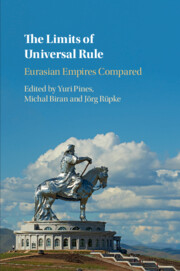Book contents
- The Limits of Universal Rule
- The Limits of Universal Rule
- Copyright page
- Contents
- Maps
- Figures
- Contributors
- Abbreviations
- Preface
- Introduction
- 1 From the Mediterranean to the Indus Valley: Modalities and Limitations of the Achaemenid Imperial Space
- 2 Limits of All-Under-Heaven: Ideology and Praxis of “Great Unity” in Early Chinese Empire
- 3 The Roman Empire
- 4 The Medieval Roman Empire of the East as a Spatial Phenomenon (300–1204 CE)
- 5 Early Islamic Imperial Space
- 6 The Mongol Imperial Space
- 7 The Territories and Boundaries of Empires
- 8 Delimiting the Realm Under the Ming Dynasty
- 9 The Expansion of the Qing Empire Before 1800
- 10 All Under the Tsar
- Index
- References
8 - Delimiting the Realm Under the Ming Dynasty
Published online by Cambridge University Press: 07 January 2021
- The Limits of Universal Rule
- The Limits of Universal Rule
- Copyright page
- Contents
- Maps
- Figures
- Contributors
- Abbreviations
- Preface
- Introduction
- 1 From the Mediterranean to the Indus Valley: Modalities and Limitations of the Achaemenid Imperial Space
- 2 Limits of All-Under-Heaven: Ideology and Praxis of “Great Unity” in Early Chinese Empire
- 3 The Roman Empire
- 4 The Medieval Roman Empire of the East as a Spatial Phenomenon (300–1204 CE)
- 5 Early Islamic Imperial Space
- 6 The Mongol Imperial Space
- 7 The Territories and Boundaries of Empires
- 8 Delimiting the Realm Under the Ming Dynasty
- 9 The Expansion of the Qing Empire Before 1800
- 10 All Under the Tsar
- Index
- References
Summary
This chapter examines the construction and representation of borders in China under the Ming dynasty (1368-1644). It considers the spatial dimensions of the Mongol empire, which was the Ming dynasty’s immediate predecessor. It examines the Ming court’s efforts to conquer or coopt Mongol power-holders and their territories, its plans to establish lasting control over those regions and their peoples, and its discursive and administrative strategies to describe and regulate issues of diversity and distance. The chapter reviews changes in the Ming dynasty’s geopolitical engagement in eastern Eurasia, tracing the dynasty’s loss of territory and influence along the northern and western borders and simultaneously a steady expansion of state institutions into the southwestern frontier. The essay concludes with developments during the sixteenth and seventeenth centuries, including responses to early Western European agents of empire in East Asia and, more broadly, the expansion of Chinese interest into maritime Asia.
Keywords
- Type
- Chapter
- Information
- The Limits of Universal RuleEurasian Empires Compared, pp. 284 - 315Publisher: Cambridge University PressPrint publication year: 2021
References
- 1
- Cited by

